 ?Mathematical formulae have been encoded as MathML and are displayed in this HTML version using MathJax in order to improve their display. Uncheck the box to turn MathJax off. This feature requires Javascript. Click on a formula to zoom.
?Mathematical formulae have been encoded as MathML and are displayed in this HTML version using MathJax in order to improve their display. Uncheck the box to turn MathJax off. This feature requires Javascript. Click on a formula to zoom.Abstract
Malignant melanoma (MM) is the most dangerous type of skin cancer, killing more than 1,100 people each year in Canada. Prognosis for late stage and recurrent MM is extremely poor due to insensitivity to chemotherapy drugs, and thus many patients seek complementary and alternative medicines. In this study, we examined four commonly used anticancer herbs in traditional Chinese medicine, Hedyotis diffusa, Scutellaria barbata, Lobelia chinensis, and Solanum nigrum, for their in vitro antitumor effects toward human MM cell line A-375. The crude water extract of S. nigrum (1 g of dry herb in 100 mL water) and its 2-fold dilution caused 52.8%±13.0% and 17.3%±2.7% cytotoxicity in A-375 cells, respectively (P<0.01). The crude water extract of H. diffusa caused 11.1%±12.4% cytotoxicity in A-375 cells with no statistical significance (P>0.05). Higher concentrated formulation might be needed for H. diffusa to exert its cytotoxic effect against A-375 cells. No cytotoxicity was observed in A-375 cells treated with crude water extract of S. barbata and L. chinensis. Further high performance liquid chromatography-tandem mass spectroscopy analysis of the herbal extracts implicated that S. nigrum and H. diffusa might have adopted the same bioactive components for their cytotoxic effects in spite of belonging to two different plant families. We also showed that the crude water extract of S. nigrum reduced intracellular reactive oxygen species generation in A-375 cells, which may lead to a cytostatic effect. Furthermore, synergistic effect was achieved when crude water extract of S. nigrum was coadministered with temozolomide, a chemotherapy drug for skin cancer.
Introduction
Malignant melanoma (MM) is a less common but more dangerous type of skin cancer. It accounts for about 75% of skin cancer-related deaths.Citation1 In 2015, Canadian Cancer Statistics reported that the incidence rate of MM was increased at 2.3% per year in men and 2.9% per year in women, respectively, between 2001 and 2010.Citation2 It was estimated that there would be 6,800 new MM cases and 1,170 MM deaths in Canada in 2015.Citation2 Like other types of cancer, early diagnosis is the key prognostic factor for MM. The 5-year relative survival rate is higher than 90% for early diagnosed MM patients (stages IA and IB); however, prognosis is extremely poor for deeper (>4 cm) and metastatic MM partially due to resistance development toward chemotherapy drugs.Citation3 Thus, many advanced or recurrent MM patients seek complementary and alternative medicines, expecting to achieve better therapeutic efficacy, reduced chemotherapy-related side effects, and/or a boost to the immune system.Citation4–Citation6
Oral and topical administrations of herbal extracts have been widely used to treat skin diseases including MM in traditional medicines for thousands of years even without much knowledge of the active ingredients.Citation7,Citation8 Furthermore, these practices are rarely documented in English and usually lack sufficient quality control. In recent years, a significant amount of research effort has been put into identifying and isolating anticancer components from medicinal plants, such as paclitaxel that was isolated from the bark of the Pacific yew tree.Citation9,Citation10 In fact, more than 70% of the anticancer drugs approved worldwide are natural products or their mimetic analogs.Citation11 However, this research effort did not reduce herbal usage in cancer patients.Citation12 Recently, the US Food and Drug Administration (FDA) has noticed increased herbal usage in cancer patients, updated its regulatory protocols and approved several herbal extracts, such as BZL101 and PHY906, for clinical trials.Citation13–Citation15
Hedyotis diffusa, Scutellaria barbata, Lobelia chinensis, and Solanum nigrum are four commonly used anticancer herbs, classified as nontoxic for both oral and topical administrations, in traditional Chinese medicine (TCM). H. diffusa is a major component in several TCM formulations. It has been used to treat liver, lung, colon, brain, and pancreatic cancers.Citation16 Our previous studies showed that the water extract of H. diffusa was highly cytotoxic toward human breast cancer MCF7 cells.Citation17 However, coadministration of the water extract of H. diffusa diminished the anticancer activity of three chemotherapy agents, doxorubicin, cyclophosphamide, and docetaxel.Citation18 Triterpenes and polysaccharides have been identified to be the active components in H. diffusa.Citation16,Citation19 S. barbata is another widely used herb to treat lung, liver, breast, and gastric cancers in TCM.Citation20 Its water extract, BZL101, has been approved by FDA for clinical trials and has shown promising efficacy against metastatic breast cancer.Citation13,Citation14 L. chinensis is traditionally used to treat snake bites and skin abscess. Recently, the water extract of L. chinensis was shown to possess antitumor activity against lung, colon, and liver cancers and several types of alkaloids have been identified as the active ingredients.Citation21–Citation24 S. nigrum is traditionally used to treat liver disorders, chronic skin ailments, inflammations, and diarrhea. Both water and alcohol extracts of S. nigrum exhibited anticancer activities against liver, colorectal, breast, and cervical cancers.Citation25–Citation28 The water extract of S. nigrum was also reported to inhibit the metastasis of mouse melanoma B16-F1 cells.Citation29 Various active components, including glycoalkaloids, polyphenols, polysaccharides, glycoproteins, and peptides, have been isolated from S. nigrum.Citation30–Citation34 Nevertheless, neither the water extracts of these four commonly used herbs nor their respective active components have been examined for anticancer activity against human MM. In the current study, we evaluated whether the water extracts of the herbs possess any antitumor activity and exhibit synergistic/additive effects with temozolomide, an oral analog of dacarbazine (DTIC) used for stage IV melanoma, against human MM A-375 cells.
Materials and methods
Materials
Dried whole plants of H. diffusa, S. barbata, L. chinensis, and S. nigrum were purchased from a TCM store (Calgary, AB, Canada). All chemicals and fetal bovine serum used in the current study were purchased from Sigma-Aldrich (Oakville, ON, Canada). Human MM cell line A-375 was purchased from the American Type Culture Collection (ATCC) (Manassas, VA, USA). Cell culture medium, Dulbecco’s Modified Eagle’s Medium (DMEM), was purchased from Cedarlane Laboratories (Burlington, ON, Canada). Cytotoxicity assay kit, CytoTox96 non-radioactive cytotoxicity assay, which quantitatively measures lactate dehydrogenase (LDH), was purchased from Promega Corporation (Madison, WI, USA).
Water extract preparation
For each herb, the crude water extract was prepared by boiling 1 g of the chopped herb in 100 mL deionized water for 1.5 hr. The water solution was allowed to cool down at room temperature (~23°C) for at least 2 hr before the supernatant was collected. The supernatant was then diluted serially up to 16-fold with deionized water. Both the supernatant and its serial dilutions were used for cell treatments within 24 hr.
Cell culture
Human MM cell line A-375 was cultured in T-75 culture flasks under ATCC-recommended culture conditions (DMEM media with 10% fetal bovine serum and 1% penicillin/streptomycin) at 37°C under a humidified atmosphere (5% CO2) in a Forma™ series II water-jacketed CO2 incubator purchased from ThermoFisher Scientific Inc. (Waltham, MA, USA). Cell culture media were changed every 2–3 days.
Cytotoxicity assay
All experiments except the high performance liquid chromatography-tandem mass spectrometry analysis were carried out in triplicate in the current study. For the cytotoxicity assay, human MM A-375 cells were collected from the T-75 cell culture flasks, resuspended in the culture media, and plated in 96-well culture plates with each well containing about 10,000 cells. The cells were allowed to attach and grow for 24 hr (reaching 70%–80% confluence) before being treated with the water extractions (1 g/100 mL) of H. diffusa, S. barbata, L. chinensis, and S. nigrum, as well as their respective serial-diluted solutions (2-, 4-, 8-, and 16-fold), for another 24 hr, which was the optimal treatment time predetermined from a pilot study. Cytotoxicity of the herbal water extracts was measured using the CytoTox 96® non-radioactive cytotoxicity assay. Cells treated with the culture media were used as negative control. The cytotoxicity was calculated using the following equation:
High performance liquid chromatography-tandem mass spectroscopy (HPLC-MS/MS) analysis
HPLC-MS/MS analysis of the water extracts of H. diffusa, S. barbata, L. chinensis, and S. nigrum was performed in both positive and negative ionization modes with spectra acquired in the mass range of 100–1,500 m/z using an Agilent 1200 HPLC system (Mississauga, ON, Canada) interfaced to an AB Sciex 4000 QTRAP® hybrid triple quadrupole/linear ion trap mass spectrometer equipped with the TurbolonSpray™ interface (Concord, ON, Canada). Applied Biosystems/MDS Sciex Analyst Software (Version 1.6.0) was used for system control and analysis. The reverse-phase chromatography was performed using an Agilent ZORBAX Eclipse C18 column (5 μm, 4.6×150 mm2) at 40°C. For each herbal water extract, 5 μL sample was injected into the C18 column using the Agilent 1200 Autosampler (set to 4°C) and delivered with a gradient mobile phase. The column was equilibrated with 90% water acidified with 0.1% formic acid and 10% acetonitrile acidified with 0.1% formic acid at a flow rate of 0.2 mL/min. The gradient was run for 20 min to 10% water acidified with 0.1% formic acid and 90% acetonitrile acidified with 0.1% formic acid. Then, the column was returned back to 90% water acidified with 0.1% formic acid and 10% acetonitrile acidified with 0.1% formic acid over 2 min and held under the final condition for 1 min. Total run time was 23 min. For the tandem mass spectrometric analysis, the condition was set to source temperature at 500°C, ion spray voltage at 5,500 V in positive ionization mode and −4,500 V in negative ionization mode, curtain gas at 40 psi, nebulizer gas (GS1) at 40 psi, heater gas (GS2) at 40 psi, collision cell exit potential at 10 V, and declustering potential at 40 V in positive ionization mode and −40 V in negative ionization mode. Nitrogen was used as the gas for all cases and the interface heater was on.
Reactive oxygen species (ROS) measurement
The intracellular ROS level in human MM A-375 cells was measured using modified published protocol for the dichloro-dihydro-fluorescein diacetate (DCFH-DA) assay.Citation35 Briefly, A-375 cells harvested from the T-75 flasks were plated on a black flat-bottom 96-well plate at 10,000 cells per well and incubated at 37°C for 24 hr before being treated with the water extract of S. nigrum and its serial diluted solutions (2-, 4-, 8-, and 16-fold) for another 24 hr. Cells treated with cell culture media were used as negative control. At the end of treatment, 5 μL DCFH-DA working solution (concentration: 0.1 mM) was added to each well and allowed to react with the cells for 30 min before being aspirated out. The cells were then washed twice with 200 μL 1× phosphate buffered saline (PBS) buffer; and finally 100 μL 1× PBS buffer was added into each well and fluorescence was read at excitation of 485 nm and emission of 528 nm using an Agilent 8453E UV-visible spectroscopy system.
Cytotoxicity of the water extract of S. nigrum and temozolomide combination
Human MM A-375 cells were plated in 96-well culture plates at 10,000 cells per well and allowed to attach and grow for 24 hr (reaching 70%–80% confluence) before being treated with temozolomide (final concentration: 200 μM) and its combination with the water extract of S. nigrum (1 g/100 mL) for another 24 hr. Treatment with dimethyl sulfoxide (DMSO), in which temozolomide solution was prepared, was used as negative control. Cytotoxicity of each treatment was measured using the CytoTox 96® non-radioactive cytotoxicity assay.
Statistical analysis
The experimental data were processed using Microsoft Excel 2013 and presented as mean ± standard deviation. Unpaired t-test was performed for statistical analyses using GraphPad QuickCalcs. A P-value <0.05 was considered to be statistically significant.
Results and discussion
Cytotoxicity of the herbal water extracts
H. diffusa, S. barbata, L. chinensis, and S. nigrum are four commonly used herbal plants to treat various types of cancer, such as breast, liver, and colorectal cancers, in TCM. However, there is limited literature available regarding their applications against human MM. Only two previous studies reported that water extract of S. nigrum inhibited the metastasis of mouse melanoma B16-F1 cells and the ethanol extract of H. diffusa suppressed the growth of mouse melanoma B16-F10 cells.Citation29,Citation36 To evaluate the applicability of these four herbs in treating MM, we measured the cyto-toxicity of their water extracts toward MM cell line A-375. As shown in , only S. nigrum exhibited a substantial and concentration-dependent cytotoxic effect against the A-375 cells. The water extract of S. nigrum and its 2-fold dilution increased the cytotoxicity by 52.8%±13.0% (P<0.01) and 17.3%±2.7% (P<0.01) compared to the control, respectively. As the water extract of S. nigrum was further diluted, no cytotoxicity was observed. The water extract of H. diffusa also increased the cytotoxicity by 11.1%±12.4% compared to the control; however this increase was not statistically significant (P=0.23). The clinical dose for H. diffusa is normally 2–5 times of that for S. nigrum in TCM; thus higher concentrated formulation of the water extract of H. diffusa may exhibit cytotoxic effect against A-375 cells. The water extracts of S. barbata and L. chinensis did not show any cytotoxic activity toward the A-375 cells. Higher concentrated formulation of the water extract of S. barbata or L. chinensis might still not be cytotoxic to the A-375 cells as their clinical doses are comparable to that for S. nigrum. Since ethanol extraction is also a common practice in TCM, further studies are warranted to investigate whether the ethanol extracts of these four herbs are cytotoxic toward human MM cells.
Figure 1 Percentage increase (mean ± standard deviation) in cytotoxicity of the crude water extracts of Hd, Sb, Lc, and Sn (extraction condition: 1 g herb in 100 mL water) and their respective serial dilutions (2-, 4-, 8-, and 16-fold) against human malignant melanoma cell line A-375.
Abbreviations: Hd, Hedyotis diffusa; Sb, Scutellaria barbata; Lc, Lobelia chinensis; Sn, Solanum nigrum.
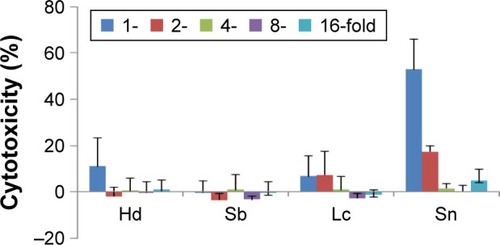
HPLC-MS/MSanalysis of the herbal water extracts
A major challenge in TCM is identification and quality control of biologically active ingredients in medicinal herbs, as the herbs are usually formulated in Fufang (combination of two or more herbs) with each herb containing hundreds of components. Recently, HPLC-MS, which allows fast separation, quantification, and even identification of compounds in a mixture, has been widely applied in analyzing herbal components.Citation37 Several classes of biologically active compounds including alkaloids, glycosides, flavonoids, polyphenols terpenoids, and saponins have been identified and characterized.Citation37 To identify why only S. nigrum was active against the MM A-375 cells, we analyzed the components of the four anticancer herbs using HPLC-MS/MS in both positive and negative ionization modes. In the positive ionization mode, the total ion current (TIC) chromatogram showed that a peak region with retention time between 1.8 to 5.5 min was only present in the water extracts of S. nigrum and H. diffusa (). We subsequently examined the ions in this peak region (). Surprisingly, we discovered that most of the abundant ions (m/z at 102.6, 279.6, 295.7, 352.9, 369.8, 761.3, 773.2, 775.2, 785.3, 801.3, 803.3, 809.3, and 817.3) were shared by both herbs, suggesting that S. nigrum and H. diffusa, which belong to different plant families (Solanaceae versus Rubiaceae), might use the same bioactive components for their cytotoxic effects against MM A-375 cells. The major difference in ion composition was that S. nigrum contained ions with m/z of 702.2, 747.2, 821.3, and 833.3, whereas H. diffusa contained ions with m/z at 704.3, 759.2, 839.2, and 855.5. α-Solanin and solanidine, two major bioactive alkaloids identified in S. nigrum, were confirmed not to present or with minimal quantity in the fraction eluted between 1.8 and 5.5 min upon comparing with their fragmentation pattern reported previously.Citation38 We hypothesized that components eluted from the C18 column within this retention time range were responsible for the cytotoxicity of S. nigrum and more concentrated water extract of H. diffusa would be cytotoxic toward A-375 cells. Studies have already been initiated to prove our hypothesis and confirm the identities of the components. Furthermore, the purpose of coadministration of S. nigrum and H. diffusa in TCM might be to increase the concentration of bioactive components. As for the negative ionization mode, we observed a unique peak region with retention time between 5.5 and 6.8 min for S. nigrum from the TIC chromatogram (). The ions in this peak region were smaller in size compared to those in the positive ionization mode (), with the abundant ions having m/z of 128.3, 165.3, 175.3, 197.4, 204.4, 227.4, 279.4, 281.5, 311.6, 317.5, 331.4, 347.4, 395.7, and 451.5. Further studies are warranted to elucidate whether components eluted from the C18 column at retention time between 5.5 and 6.8 min also contribute to the cytotoxic effect of S. nigrum.
Figure 2 HPLC-MS/MS analysis of the crude water extracts of Hedyotis diffusa, Scutellaria barbata, Lobelia chinensis, and Solanum nigrum (extraction condition: 1 g herb in 100 mL water) in positive ionization mode.
Abbreviations: HPLC-MS/MS, high performance liquid chromatography-tandem mass spectroscopy; cps, counts per second.
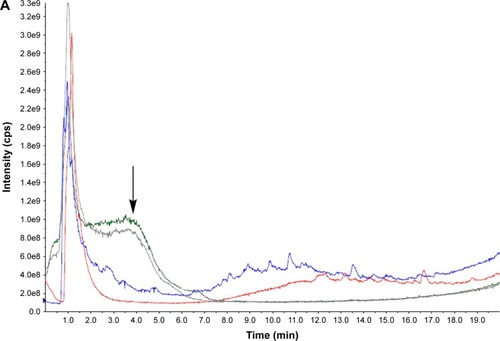
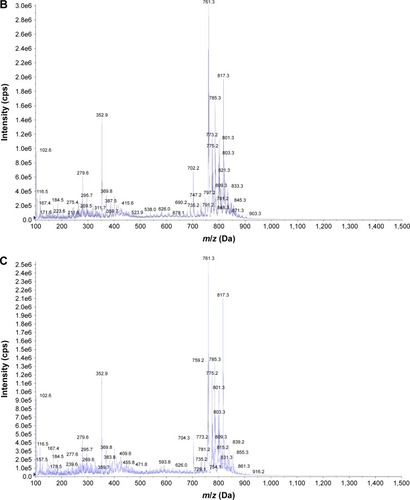
Figure 3 HPLC-MS/MS analysis of the crude water extracts of Hedyotis diffusa, Scutellaria barbata, Lobelia chinensis, and Solanum nigrum (extraction condition: 1 g herb in 100 mL water) in negative ionization mode.
Abbreviations: HPLC-MS/MS, high performance liquid chromatography-tandem mass spectroscopy; TIC, total ion current; cps, counts per second.
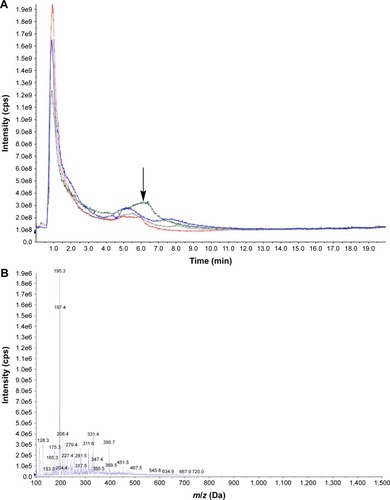
Water extract of S. nigrum reduced intracellular ROS level in A-375 cells
Excessive ultraviolet (UV) exposure has been identified as a major risk factor for MM.Citation39 UVA (320–400 nm) radiation can raise intracellular ROS generation and cause melanin-dependent oxidative DNA damages in melanocytes.Citation40,Citation41 In fact, MM cells maintain a much higher level of intracellular ROS than most other types of cancer.Citation42–Citation44 Furthermore, ROS are generally believed to promote MM invasion and metastasis.Citation45,Citation46 Therefore, we investigated whether the water extract of S. nigrum has any effects on ROS generation. Cultured MM A-375 cells were treated with the water extract of S. nigrum and its serial dilutions for 24 hr and the intracellular ROS level was measured using the DCFH-DA assay. As shown in , the ROS level in A-375 cells was reduced to 24.7%±5.0% (P<0.01) upon treatment with the water extract of S. nigrum compared to the control. The 2- and 16-fold dilutions of the S. nigrum water extract also reduced the ROS level in A-375 cells to 79.1%±36.3% (P=0.11) and 83.9%±35.9% (P=0.21) compared to the control, respectively, however these ROS reductions were not statistically significant. Interestingly, the intracellular ROS level in A-375 cells was increased to 122.1%±17.2% (statistically significant, P=0.03) and 110.9%±32.5% (P=0.37) upon treatment with the 4- and 8-fold dilutions of the S. nigrum water extract, respectively. Thus, we concluded that the water extract of S. nigrum possessed cytostatic effect via reducing intracellular ROS generation in additional to its cytotoxic effect toward human MM A-375 cells. Further studies, including the expression of key ROS-related enzymes such as catalase, glutathione peroxidase, and superoxide dismutase, are warranted to fully understand how the water extract of S. nigrum reduces the intracellular ROS generation.
Figure 4 Effects of the crude water extract of Solanum nigrum and its serial dilutions (2-, 4-, 8-, and 16-fold) on intracellular ROS generation (mean ± standard deviation) in human malignant melanoma A-375 cells.
Abbreviation: ROS, reactive oxygen species.
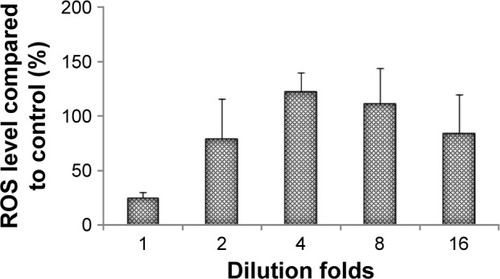
Synergistic effect between the water extract of S. nigrum and temozolomide
Advanced MM generally does not respond to chemotherapy and DTIC is the only commonly used chemotherapy drug with a response rate of about 15%.Citation47 Temozolomide, an oral analog of DTIC, has been extensively evaluated in treating advanced MM.Citation48–Citation52 However, its new drug application (NDA 21-051) for melanoma was denied by FDA due to a lack of evidence showing therapeutic advantage over DTIC. A randomized phase III trial showed that coadministration of temozolomide and interferon α2b (INF-α2b) increased the response rate from 13% to 24% and overall survival time from 8.4 to 9.7 months.Citation53 Since various herbal water extracts have been reported to potentiate the therapeutic efficacy of chemotherapy drugs,Citation25,Citation26,Citation54–Citation56 we evaluated whether the water extract of S. nigrum exhibits synergistic/additive effect with temozolomide against human MM A-375 cells. As illustrated in , the cytotoxicity of the coadministered temozolomide and water extract of S. nigrum was increased statistically significantly to 97.0%±3.6% from 31.0%±7.5% for temozolomide (P<0.01) and 55.0%±17.6% for the water extract of S. nigrum (P=0.03), implicating synergistic effect was achieved between temozolomide and the water extract of S. nigrum against human MM A-375 cells. Our current study suggests that oral administration of temozolomide and the water extract of S. nigrum or oral administration of temozolomide in combination with topical wash with the water extract of S. nigrum is worthy of further investigation using a patient-derived xenograft or a mouse xenograft melanoma model.
Figure 5 Percentage increase (mean ± standard deviation) in cytotoxicity of the crude water extract of Sn (1 g herb in 100 mL water), TMZ (200 μM), and their combination (Sn+TMZ) against human malignant melanoma cell line A-375.
Abbreviations: DMSO, dimethyl sulfoxide; Sn, S. nigrum; TMZ, temozolomide.
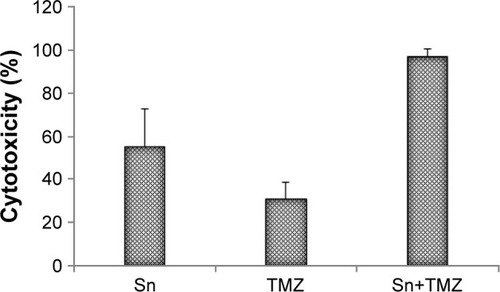
Conclusion
In this study, we evaluated the cytotoxicity of the water extracts of H. diffusa, S. barbata, L. chinensis, and S. nigrum toward human MM A-375 cells. S. nigrum was the only cytotoxic herb at extraction condition of 1 g herb in 100 mL water. Our HPLC-MS/MS analysis showed that S. nigrum and H. diffusa might adopt the same bioactive components for their cytotoxic functions and higher concentrated formulation of the water extract of H. diffusa would exhibit cytotoxic effect against A-375 cells. The water extract of S. nigrum was also shown to possess cytostatic activity toward MM A-375 cells through decreasing intracellular ROS generation. Furthermore, synergistic effect was observed between the water extract of S. nigrum and temozolomide. Based on the current results, we hypothesized that coadministration of the water extract of S. nigrum could improve the therapeutic efficacy of temozolomide, as well as DTIC, against human MM. Further studies are warranted to prove our hypothesis using a patient-derived xenograft or a mouse xenograft melanoma model.
Acknowledgments
This work was supported by an internal research grant from the College of Pharmacy and Nutrition, University of Saskatchewan.
Disclosure
The authors report no conflicts of interest in this work.
References
- American Cancer SocietyCancer Facts & FiguresAtlanta2014
- Canadian Cancer SocietyCanadian Cancer StatisticsCanadaPublic Health Agency of Canada2015
- HelmbachHRossmannEKernMASchadendorfDDrug-resistance in human melanomaInt J Cancer20019361762211477569
- HemaIswaryaSDobleMPotential synergism of natural products in the treatment of cancerPhytother Res2006404239249
- ChengKCLiYXChengJTThe use of herbal medicine in cancer-related anorexia/cachexia treatment around the worldCurr Pharm Des201218314819482622632862
- YangCChienLYTaiCJUse of complementary and alternative medicine among patients with cancer receiving outpatient chemotherapy in TaiwanJ Altern Complement Med200814441341618435601
- ShenefeltPDHerbal treatment for dermatologic disordersBenzieIFFWachtel-GalorSHerbal Medicine: Biomolecular and Clinical Aspects2nd edBoca RatonCRC Press/Taylor & Francis2011383404
- ZinkATraidl-HoffmannCGreen tea in dermatology – myths and factsJ Dtsch Dermatol Ges201513876877526177066
- RiondelJJacrotMPicotFBerielHMouriquandCPotierPTherapeutic response to taxol of six human tumors xenografted into nude miceCancer Chemother Pharmacol19861721371422872974
- SlichenmyerWJVon HoffDDTaxol: a new and effective anti-cancer drugAnticancer Drugs1991265195301687206
- Wachtel-GalorSBenzieIFFHerbal medicine: an introduction to its history, usage, regulation, current trends, and research needsBenzieIFFWachtel-GalorSHerbal Medicine: Biomolecular and Clinical Aspects2nd edBoca RatonCRC Press/Taylor & Francis2011110
- DamerySGratusCGrieveRThe use of herbal medicines by people with cancer: a cross-sectional surveyBr J Cancer2011104692793321364591
- RugoHShtivelmanEPerezAPhase I trial and antitumor effects of BZL101 for patients with advanced breast cancerBreast Cancer Res Treat20071051172817111207
- PerezATArunBTripathyDA phase 1B dose escalation trial of Scutellaria barbata (BZL101) for patients with metastatic breast cancerBreast Cancer Res Treat2010120111111820054647
- SaifMWLiJLambLFirst-in-human phase II trial of the botanical formulation PHY906 with capecitabine as second-line therapy in patients with advanced pancreatic cancerCancer Chemother Pharmacol201473237338024297682
- ShaoJGongGTrombettaLAn evidence-based perspective of Hedyotis diffusa or Oldenlandia diffusa (spreading Hedyotis) for cancer patientsChoWCSEvidence Based Anticancer Material MedicaBerlinSpringer2011179192
- LingBDongQSunWEvaluating the anticancer activity of Hedyotis diffusa water extract against human breast cancer MCF7 cellsOpen Nat Prod J20136114
- DongQLingBGaoBMaleyJSammynaikenRYangJHedyotis diffusa water extract diminished the cytotoxic effects of chemotherapy drugs against human breast cancer MCF7 cellsNat Prod Commun2014969970025026725
- LiCZhaoYGuoZZhangXXueXLiangXEffective 2D-RPLC/RPLC enrichment and separation of micro-components from Hedyotis diffusa Willd and characterization by using ultra-performance liquid chromatography/quadrupole time-of-flight mass spectrometryJ Pharm Biomed Anal201499354425061712
- YeLJiaYJiKETraditional Chinese medicine in the prevention and treatment of cancer and cancer metastasisOncol Lett20151031240125026622657
- ChenMWChenWRZhangJMLongXYWangYTLobelia chinensis: chemical constituents and anticancer activity perspectiveChin J Nat Med201412210310724636059
- HanSRLvXYWangYMA study on the effect of aqueous extract of Lobelia chinensis on colon precancerous lesions in ratsAfr J Tradit Complement Altern Med2013106422425
- SantosaMHHerzogRVoelterWAntitumor activity of the hot water extract of Lobelia chinensisPlanta Med19866555
- YangSShenTZhaoLChemical constituents of Lobelia chinensisFitoterapia20149316817424444893
- WangCKLinYFTaiCJIntegrated treatment of aqueous extract of Solanum nigrum-potentiated cisplatin- and doxorubicin-induced cytotoxicity in human hepatocellular carcinoma cellsEvid Based Complement Alternat Med2015201567527026221175
- TaiCJWangCKTaiCJAqueous extract of Solanum nigrum leaves induces autophagy and enhances cytotoxicity of cisplatin, doxorubicin, docetaxel, and 5-fluorouracil in human colorectal carcinoma cellsEvid Based Complement Alternat Med2013201351471923843876
- LaiYJTaiCJWangCWAnti-cancer activity of solanum nigrum (AESN) through suppression of mitochondrial function and epithelial-mesenchymal transition (EMT) in breast cancer cellsMolecules2016215 pii E553
- LiJLiQFengTLiKAqueous extract of Solanum nigrum inhibit growth of cervical carcinoma (U14) via modulating immune response of tumor bearing mice and inducing apoptosis of tumor cellsFitoterapia2008797–854855618687388
- WangHCWuDHChangYCLiYJWangCJSolanum nigrum Linn. water extract inhibits metastasis in mouse melanoma cells in vitro and in vivoJ Agric Food Chem20105822119131192321028816
- DingXZhuFYangYLiMPurification, antitumor activity in vitro of steroidal glycoalkaloids from black nightshade (Solanum nigrum L.)Food Chem201314121181118623790901
- YangMYHsuLSPengCHShiYSWuCHWangCJPolyphenol-rich extracts from Solanum nigrum attenuated PKC alpha-mediated migration and invasion of hepatocellular carcinoma cellsJ Agric Food Chem20105895806581420349911
- LiJLiQWGaoDWHanZSLuWZAntitumor and immunomodulating effects of polysaccharides isolated from Solanum nigrum LinnePhytother Res200923111524153019449342
- HeoKSLeeSJKoJHLimKLimKTGlycoprotein isolated from Solanum nigrum L. inhibits the DNA-binding activities of NF-kappaB and AP-1, and increases the production of nitric oxide in TPA-stimulated MCF-7 cellsToxicol In Vitro200418675576315465640
- JeongJBDe LumenBOJeongHJLunasin peptide purified from Solanum nigrum L. protects DNA from oxidative damage by suppressing the generation of hydroxyl radical via blocking fenton reactionCancer Lett20102931586420083341
- LingBGaoBYangJEvaluating the effects of tetrachloro-1,4- benzoquinone, an active metabolite of pentachlorophenol, on the growth of human breast cancer cellsJ Toxicol20162016825372626981120
- KuoYJYangJSLuCCChiangSYLinJGChungJGEthanol extract of Hedyotis diffusa willd upregulates G0/G1 phase arrest and induces apoptosis in human leukemia cells by modulating caspase cascade signaling and altering associated genes expression was assayed by cDNA microarrayEnviron Toxicol201530101162117724677778
- LiMHouXFZhangJWangSCFuQHeLCApplications of HPLC/MS in the analysis of traditional Chinese medicinesJ Pharm Anal2011128191
- JensenPHJuhlerRKNielsenNJPotato glycoalkaloids in soil-optimising liquid chromatography-time-of-flight mass spectrometry for quantitative studiesJ Chromatogr A200811821657118221744
- LoJAFisherDEThe melanoma revolution: from UV carcinogenesis to a new era in therapeuticsScience2014346621294594925414302
- SwalwellHLatimerJHaywoodRMBirch-MachinMAInvestigating the role of melanin in UVA/UVB- and hydrogen peroxide-induced cellular and mitochondrial ROS production and mitochondrial DNA damage in human melanoma cellsFree Radic Biol Med201252362663422178978
- KamenischYBabanTSSchullerWUVA-irradiation induces melanoma invasion via enhanced Warburg effectJ Invest Dermatol201613691866187527185340
- SanderCSHammFElsnerPThieleJJOxidative stress in malignant melanoma and non-melanoma skin cancerBr J Dermatol2003148591392212786821
- SzatrowskiTPNathanCFProduction of large amounts of hydrogen peroxide by human tumor cellsCancer Res19915137947981846317
- GidanianSMentelleMMeyskensFLJrFarmerPJMelanosomal damage in normal human melanocytes induced by UVB and metal uptake – a basis for the pro-oxidant state of melanomaPhotochem Photobiol200884355656418331399
- LinXZhengWLiuJOxidative stress in malignant melanoma enhances tumor necrosis factor-α secretion of tumor-associated macrophages that promote cancer cell invasionAntioxid Redox Signal201319121337135523373752
- JoosseADe VriesEvan EijckCHEggermontAMNijstenTCoeberghJWReactive oxygen species and melanoma: an explanation for gender differences in survival?Pigment Cell Melanoma Res201023335236420218981
- FinnLMarkovicSNJosephRWTherapy for metastatic melanoma: the past, present, and futureBMC Med2012102322385436
- AzzabiAHughesANCalvertPMPhase I study of temozolomide plus paclitaxel in patients with advanced malignant melanoma and associated in vitro investigationsBr J Cancer20059261006101215756276
- BafaloukosDTsoutsosDKalofonosHTemozolomide and cisplatin versus temozolomide in patients with advanced melanoma: a randomized phase II study of the Hellenic Cooperative Oncology GroupAnn Oncol200516695095715829494
- MiddletonMRGrobJJAaronsonNRandomized phase III study of temozolomide versus dacarbazine in the treatment of patients with advanced metastatic malignant melanomaJ Clin Oncol200018115816610623706
- AlrwasAPapadopoulosNECainSPhase I trial of biochemotherapy with cisplatin, temozolomide, and dose escalation of nab-paclitaxel combined with interleukin-2 and interferon-α in patients with metastatic melanomaMelanoma Res201424434234824743052
- BeasleyGMSpeicherPAugustineCKA multicenter phase I dose escalation trial to evaluate safety and tolerability of intra-arterial temozolomide for patients with advanced extremity melanoma using normothermic isolated limb infusionAnn Surg Oncol201522128729425145500
- KaufmannRSpiethKLeiterUTemozolomide in combination with interferon-alfa versus temozolomide alone in patients with advanced metastatic melanoma: a randomized, phase III, multicenter study from the dermatologic cooperative oncology groupJ Clin Oncol200523359001900716260697
- SharmaGTyagiAKSinghRPChanDCAgarwalRSynergistic anti-cancer effects of grape seed extract and conventional cytotoxic agent doxorubicin against human breast carcinoma cellsBreast Cancer Res Treat200485111215039593
- XuWWLiBLaiETWater extract from Pleurotus pulmonarius with antioxidant activity exerts in vivo chemoprophylaxis and chemo-sensitization for liver cancerNutr Cancer201466698999825072857
- ChenNCChyauCCLeeYJTsengHCChouFPPromotion of mitotic catastrophe via activation of PTEN by paclitaxel with supplement of mulberry water extract in bladder cancer cellsSci Rep201662041726838546
